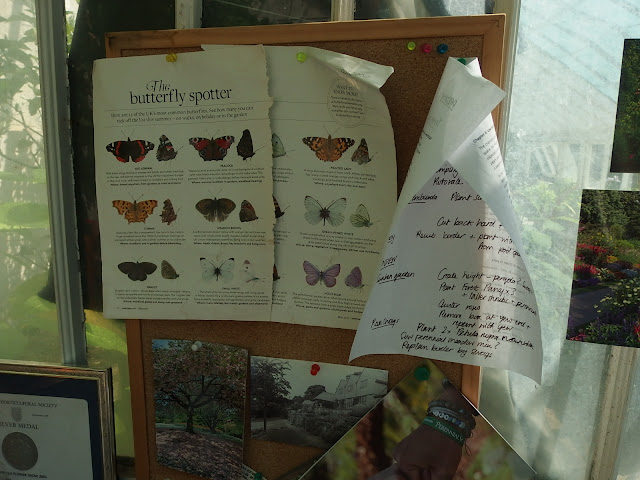In the garden with Jane Moore and Planting for Butterflies
Of course mother nature conspired against us on Friday and produced the third hottest day of the year ever in the UK. As a result the butterflies decided to flutter off elsewhere with only the odd tired cabbage white or two plus a gatekeeper putting in a brief appearance during our time together. As you can see we retired to the gazebo instead to shelter from the heat and chat merrily away about the garden and all things butterfly.
There was also time for a cuppa, where I spotted Jane's handy butterfly guide pinned to her notice board in the greenhouse. I also got the full tour of the hotel's three acre garden (you can also read Jane's guide here), an oasis of bliss from bustling Bath where she has gardened for 17 years. Whilst mindful of the needs of the hotel's guests, Jane has had the freedom to shape the garden with her own ideas and favourite plants.
We all love seeing butterflies in our gardens, but there is a tension between welcoming them and the dreaded cabbage white caterpillars scoffing anything and everything in the cabbage plant family. Here we are in the kitchen garden looking at Jane's top tip: grow nasturtiums as a decoy crop - something I used to do on my allotment. Of course they'll fit neatly into any garden - not just those with vegetables - where the butterflies will lay their eggs ready for the caterpillars to chomp away. It seems they like their food on the spicy side and Jane added successive generations go on to lay their eggs on the nasturtiums in preference and leave other plants relatively well alone. Nasturtiums can be tucked in somewhere in any garden, from a small pot through to a whole bed as shown in the photo.
If bright nasturtiums aren't your thing, then Jane recommends verbena as an alternative. Unlike Buddleja - which is great for certain butterflies - verbena's shorter tubular flowers suit a wider range of these insects as Buddleja's tubes are too long for the browns to feed. As you can see, bees like verbena too. Jane told me that if you're already gardening to encourage bees, then you're doing plenty of good for butterflies too as both go for nectar-rich plants. Another good plant for this time of the year is lavender.
We also chatted about identifying those pesky blues. I've spent ages chasing them around the garden trying to get a photo, only for them to merrily fly away over the fence before I can do so. It seems observing them can give us a big clue to their ID: common blues usually fly low over our borders; if your blue is fluttering away on high for most of the time, then it's more likely to be a holly blue. Jane confirmed my tentative ID as I'd seen plenty of blues this year high up on the ivy on my garden fence: holly blues like ivy as well as holly. If they settle and close their wings, then the photos on the Big Butterfly Count ID sheet (as shown above) clearly show how different they are.
I asked Jane about her favourite plant for butterflies. She asked for two (and quite rightly so); firstly asters, especially Aster amellus (Michaelmas daisies) for later in the season. These are more mildew resistant and usually earlier to flower, so take our butterflies neatly from summer into the autumn. Her other favourite is sweet rocket (Hesperis matronalis) for the spring to early summer, especially as it feeds early emerging butterflies such as her favourite, the Orange Tip. Other good spring flowers are Cardamine pratensis aka cuckoo flower, hedge mustard and honesty.
The butterfly's lifespan is relatively short, from days to a few weeks, hence their vulnerability if we experience cooler summer weather (we think the recent spell of cool weather may have affected our butterfly spotting on Friday as well as the drought earlier this year which means many of the nectar rich flowers have already gone over). However, some species can overwinter in the UK, such as the peacock butterfly shown in the photo. Red admirals and painted ladies are common UK hibernators too and are those tatty specimens you may find fluttering weakly in your garden in spring. If one of these flutters into your house in the autumn seeking a quiet, often high corner to sleep the winter away, then Jane's advice is to gently relocate it to a shed or outhouse.
Thanks Jane for the generosity of your time on Friday to show me around your fabulous domain and to talk all things butterfly!
If you love butterflies and want to know more about them, then look no further than Jane's book, Planting for Butterflies. It's a charming volume, packed with information for those with no knowledge of the subject, but also with sufficient depth for those who'd like to know much more. It's not just about gardening, you'll also learn about the lifecycle of butterflies, their conservation and their importance in your garden's wildlife food chain. It shows they're so much more than pretty things that flutter in our garden to bring us entertainment and pleasure.
Don't forget that there's still time to do this year's Big Butterfly Count as it goes on until August 9th. I see the weather forecast is set fair for many of us over the next week; what could be better than 15 minutes spent in the garden counting butterflies?
Don't forget that there's still time to do this year's Big Butterfly Count as it goes on until August 9th. I see the weather forecast is set fair for many of us over the next week; what could be better than 15 minutes spent in the garden counting butterflies?



















Comments
Post a Comment
I love hearing from you and welcome thoughtful conversations :)
Comments aiming to link back and give credence to commercial websites will be composted!